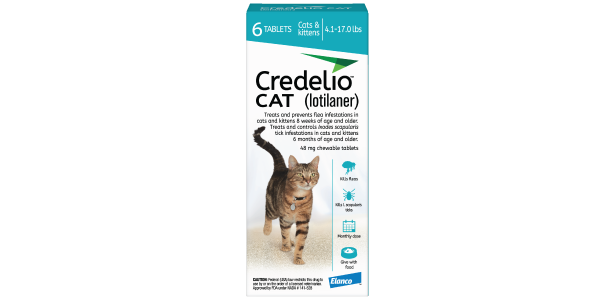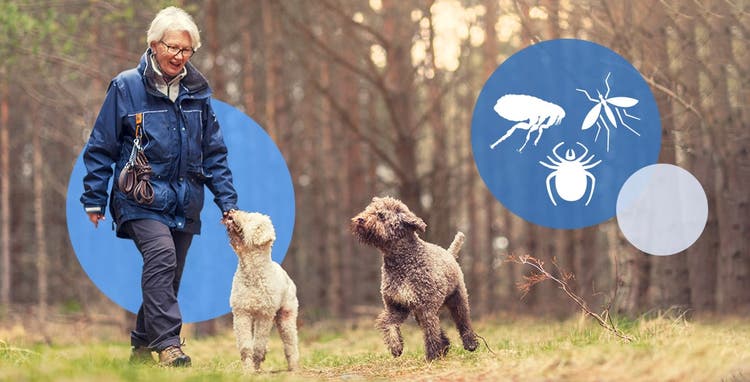Understanding flea and tick life cycles can help you protect your pet and home.
The Flea Life Cycle
The flea life cycle typically lasts around 12 days, and adult fleas can lay up to 50 eggs a day – which is why using flea prevention and controlling flea infestations when they do happen is essential.
A typical flea life cycle looks like this:
1. Fleas enter your home.
Once fleas have entered your home, carried in from your clothing, shoes or on your cat or dog’s fur, they will begin reproducing within 24 hours.
2. Adult fleas lay eggs.
After a blood meal, fleas will lay eggs around the house in carpet, upholstery, clothing or car fabric, as well as in corners, behind baseboards and in other nooks and crannies. Anywhere your pet goes, flea eggs will be dropping off into the surroundings.
3. Flea eggs hatch.
Flea eggs hatch much faster in warmer environments, and require a humidity level of at least 50%. Flea eggs typically cannot survive long below freezing temperatures.
4. Larvae grow to pupae.
Flea eggs develop into larvae, and then pupae, before becoming adult fleas that jump on your pet, blood feed and lay new eggs, starting the process all over.
The Risks Associated with Fleas
Fleas can spell discomfort for both our pets and for us. But in addition to causing skin irritations and relentless itching, fleas can also pass along parasites and other issues like:
- Tapeworms in dogs and cats
- Bartonellosis in cats
- Flea allergy dermatitis (FAD), in dogs and cats
The Tick Life Cycle
Ticks go through four stages throughout their life cycle: egg, larva, nymph and adult. Ticks can bite and feed on dogs and cats during their larval, nymph and adult stages:
1. Ticks hitch a ride and start feeding.
Once ticks latch onto your cat or dog, they typically feed, mate and typically feed and mate right on your pet.
2. Female ticks lay eggs.
When ready, female ticks will fall off your pet, where they can lay thousands of eggs in the environment.
3. The tick eggs hatch, and larvae feed.
The larvae that hatch from these eggs attach to hosts like small mammals or your pet.
4. Larvae molt to nymphs.
Once becoming nymphs, they find new hosts to feed again.
5. Nymphs hatch into adult ticks.
Once nymphs become adults, the tick life cycle begins again.
The Risks Associated with Ticks
Ticks are especially effective at passing diseases because they feed on several hosts, molt through different life stages, require large blood meals and feed for long periods of time. And though ticks prefer warmer environments, they can survive in the cold, and even under snow, meaning they can be active all year long.
Ticks are capable of transmitting diseases to pets such as:
- Lyme disease
- Rocky Mountain spotted fever
- Ehrlichiosis
- Anaplasmosis
Breaking the Flea and Tick Life Cycles
Once you discover fleas or ticks on your pet, you’ll want to take steps to help get rid of them quickly. Find out how to help get rid of fleas in your home and how to help get rid of ticks and fleas in your yard.

Seresto® Flea & Tick Collar for Dogs
An easy-to-use, odorless, non-greasy collar that kills and repels fleas and ticks for 8 continuous months.

Seresto® Flea & Tick Collar for Cats
An easy-to-use, odorless, non-greasy collar that kills and repels fleas and ticks for 8 continuous months.

Credelio® CAT (lotilaner)
Protect your feline friend with Credelio Cat, the first and only flea and tick chewable for cats.

K9 Advantix® II
A convenient, monthly topical application that kills and repels fleas and ticks through contact, so they don't have to bite your dog to die. Do not use on cats.
Credelio® CAT (lotilaner)
Indications:
Credelio CAT kills adult fleas and is indicated for the treatment and prevention of flea infestations for one month in cats and kittens 8 weeks of age and older and weighing 2 pounds or greater.
Credelio CAT is also indicated for treatment and control of black-legged tick infestations for one month in cats and kittens 6 months of age and older and weighing 2 pounds or greater.
Important Safety Information:
Lotilaner is a member of the isoxazoline class of drugs. This class has been associated with neurologic adverse reactions including tremors, incoordination, and seizures. Neurologic adverse reactions have been reported in cats receiving isoxazoline class drugs, even in cats without a history of neurologic disorders. Use with caution in cats with a history of neurologic disorders. The safety of Credelio CAT has not been established in breeding, pregnant and lactating cats. The effectiveness of Credelio CAT against black-legged ticks in kittens less than 6 months of age has not been evaluated. The most frequently reported adverse reactions are weight loss, rapid breathing and vomiting. For complete safety information, please see Credelio CAT product label or ask your veterinarian.


